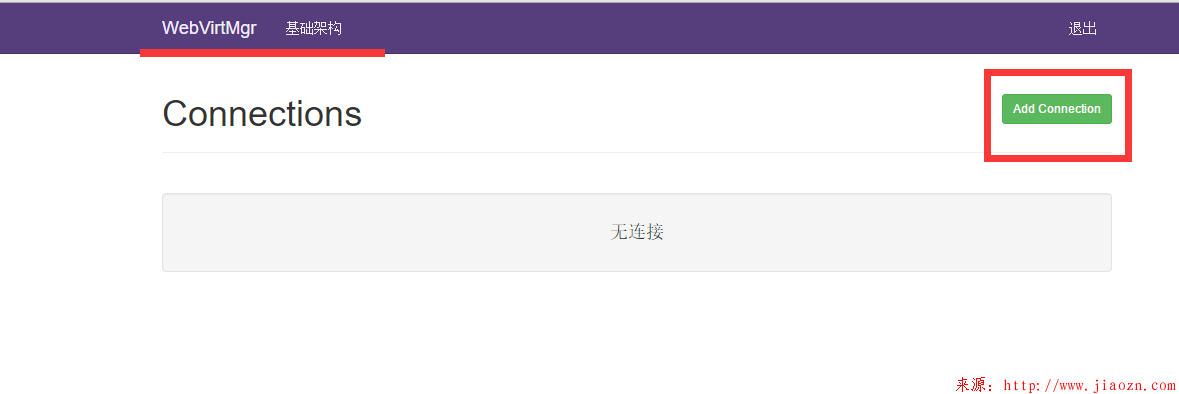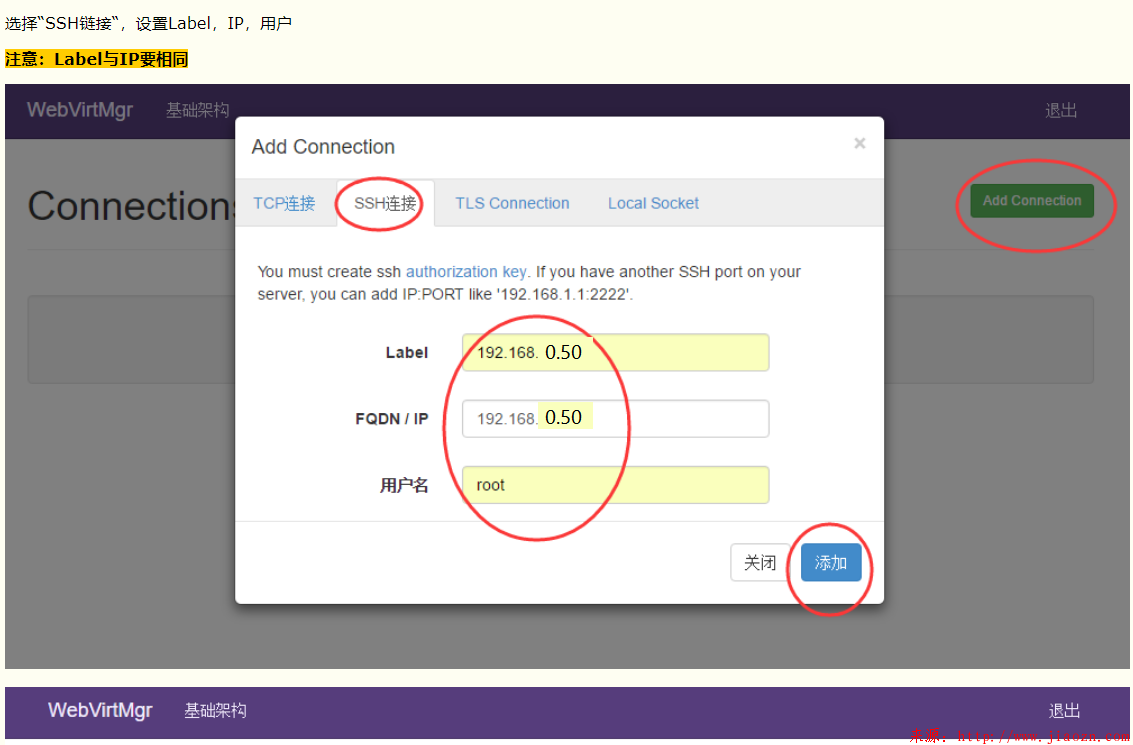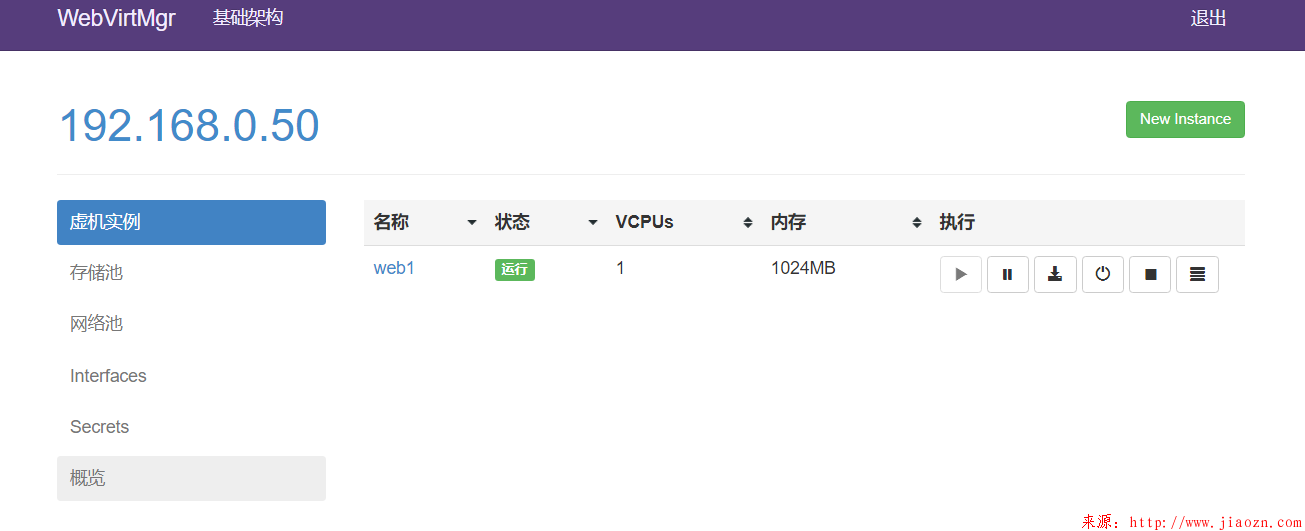【虚拟化】centos7.2 kvm虚拟化管理平台WebVirtMgr部署
2020年05月14日 12:12:41 作者:Jiaozn 分类:虚拟化 评论(0)在服务器上部署kvm虚拟化,虚出多台VM出来,以应对新的测试需求。
当KVM宿主机越来越多,需要对宿主机的状态进行调控,决定采用WebVirtMgr作为kvm虚拟化的web管理工具,图形化的WEB,让人能更方便的查看kvm 宿主机的情况和操作
WebVirtMgr是近两年来发展较快,比较活跃,非常清新的一个KVM管理平台,提供对宿主机和虚机的统一管理,它有别于kvm自带的图形管理工具(virtual machine manager),让kvm管理变得更为可视化,对中小型kvm应用场景带来了更多方便。
WebVirtMgr采用几乎纯Python开发,其前端是基于Python的Django,后端是基于Libvirt的Python接口,将日常kvm的管理操作变的更加的可视化。
WebVirtMgr特点
操作简单,易于使用
通过libvirt的API接口对kvm进行管理
提供对虚拟机生命周期管理
WebVirtMgr 功能
宿主机管理支持以下功能
CPU利用率
内存利用率
网络资源池管理
存储资源池管理
虚拟机镜像
虚拟机克隆
快照管理
日志管理
虚机迁移
虚拟机管理支持以下功能
CPU利用率
内存利用率
光盘管理
关/开/暂停虚拟机
安装虚拟机
VNC console连接
创建快照
下面对部署过程进行记录,希望能帮助到有用到的朋友们。
这里我将webvirtmgr服务器和kvm服务器放在同一台机器上部署的,即单机部署
系统:Centos 7.2
内存:64G
CPU:32核
ip:192.168.56.50(内网),192.168.0.29(外网)
一、基础环境
#close firewalld and NetworkManager [root@linux-node1 ~]# systemctl disable firewalld [root@linux-node1 ~]# systemctl disable NetworkManager #关闭SELinux sed -i 's/SELINUX=enforcing/SELINUX=disabled/g' /etc/selinux/config setenforce 0
1.1 开启blos 开启vt,检查
1)查看是否支持虚拟机 说明1:半虚拟化是不能运行与安装KVM虚拟机的。 [root@ops ~]#egrep '(vmx|svm)' --color=always /proc/cpuinfo
1.2 系统版本
[root@webvirtmgr-node1 ~]# cat /etc/redhat-release CentOS Linux release 7.2.1511 (Core) [root@webvirtmgr-node1 ~]# uname -r 3.10.0-327.el7.x86_64
1.3 安装epel源
#备份源 yum install wget -y mv /etc/yum.repos.d/CentOS-Base.repo /etc/yum.repos.d/CentOS-Base.repo.backup wget -O /etc/yum.repos.d/CentOS-Base.repo http://mirrors.aliyun.com/repo/Centos-7.repo yum -y install epel-release yum clean all yum makecache #install software yum install net-tools vim lrzsz -y
1.4 安装kvm软件
yum install qemu-kvm libvirt libvirt-python libguestfs-tools virt-install virt-manager python-virtinst libvirt-client virt-viewer -y
1.5 本机网络
[root@webvirtmg ~]# ip a 1: lo: <LOOPBACK,UP,LOWER_UP> mtu 65536 qdisc noqueue state UNKNOWN link/loopback 00:00:00:00:00:00 brd 00:00:00:00:00:00 inet 127.0.0.1/8 scope host lo valid_lft forever preferred_lft forever inet6 ::1/128 scope host valid_lft forever preferred_lft forever 2: eth0: <BROADCAST,MULTICAST,UP,LOWER_UP> mtu 1500 qdisc pfifo_fast state UP qlen 1000 link/ether 00:0c:29:68:4b:e3 brd ff:ff:ff:ff:ff:ff inet 192.168.0.50/24 brd 192.168.0.255 scope global eth0 valid_lft forever preferred_lft forever inet6 fe80::20c:29ff:fe68:4be3/64 scope link valid_lft forever preferred_lft forever 3: eth1: <BROADCAST,MULTICAST,UP,LOWER_UP> mtu 1500 qdisc pfifo_fast state UP qlen 1000 link/ether 00:0c:29:68:4b:ed brd ff:ff:ff:ff:ff:ff inet 192.168.56.50/24 brd 192.168.56.255 scope global eth1 valid_lft forever preferred_lft forever inet6 fe80::20c:29ff:fe68:4bed/64 scope link valid_lft forever preferred_lft forever
1.6 配置桥接网络,(备注:br0绑定eth1)
[root@webvirtmg ~]# cd /etc/sysconfig/network-scripts/ [root@webvirtmg network-scripts]# cat ifcfg-eth1 TYPE=Ethernet BOOTPROTO=static DEFROUTE=yes IPV4_FAILURE_FATAL=no NAME=eth1 DEVICE=eth1 ONBOOT=yes IPADDR=192.168.56.50 PREFIX=24 GATEWAY=192.168.56.2 DNS1=192.168.56.2 BRIDGE=br0 NM_CONTROLLED=no [root@webvirtmg network-scripts]# cat ifcfg-br0 TYPE=Bridge DEVICE=br0 NM_CONTROLLED=no BOOTPROTO=static DEFROUTE=yes IPV4_FAILURE_FATAL=no NAME=eth1 ONBOOT=yes IPADDR=192.168.56.50 PREFIX=24 GATEWAY=192.168.56.2 DNS1=192.168.56.2
#重启网络服务
systemctl restart network
1.7 启动libvirt
[root@webvirtmgr-node1 ~]# systemctl restart libvirtd [root@webvirtmgr-node1 ~]# systemctl status libvirtd
1.8 测试
[root@webvirtmgr-node1 ~]# virsh -c qemu:///system list Id Name State ---------------------------------------------------- [root@webvirtmgr-node1 ~]# virsh --version 3.9.0 [root@webvirtmgr-node1 ~]# virt-install --version 1.4.3 [root@webvirtmgr-node1 ~]# ln -s /usr/libexec/qemu-kvm /usr/bin/qemu-kvm [root@webvirtmgr-node1 ~]# lsmod |grep kvm kvm_intel 162153 0 kvm 525259 1 kvm_intel
1.9 查看网桥
[root@webvirtmg ~]# brctl show bridge name bridge id STP enabled interfaces br0 8000.000c29684bed no eth1 virbr0 8000.000000000000 yes
二、部署webvirtmgr
参考官网:https://github.com/retspen/webvirtmgr/wiki/Install-WebVirtMgr
1.1 安装依赖包
yum install git python-pip libvirt-python libxml2-python python-websockify supervisor nginx -y
1.2 从git-hub中下载相关的webvirtmgr代码
[root@openstack ops]# cd /usr/local/src/ [root@openstack src]# git clone git://github.com/retspen/webvirtmgr.git (下载地址:https://pan.baidu.com/s/1pLS3kCj 获取密码:8efm)
1.3 安装webvirtmgr
[root@openstack src]# cd webvirtmgr/ [root@openstack webvirtmgr]# pip install -r requirements.txt
1.4 检查sqlite3 (备注:自带不需要安装,导入模块检查一下。)
[root@webvirtmg webvirtmgr]# python Python 2.7.5 (default, Nov 20 2015, 02:00:19) [GCC 4.8.5 20150623 (Red Hat 4.8.5-4)] on linux2 Type "help", "copyright", "credits" or "license" for more information. >>> import sqlite3 >>> exit()
1.5、初始化账号
[root@webvirtmg webvirtmgr]# pwd /usr/local/src/webvirtmgr<br> [root@webvirtmg webvirtmgr]# ./manage.py syncdb WARNING:root:No local_settings file found. Creating tables ... Creating table auth_permission Creating table auth_group_permissions Creating table auth_group Creating table auth_user_groups Creating table auth_user_user_permissions Creating table auth_user Creating table django_content_type Creating table django_session Creating table django_site Creating table servers_compute Creating table instance_instance Creating table create_flavor You just installed Django's auth system, which means you don't have any superusers defined. Would you like to create one now? (yes/no): yes Username (leave blank to use 'root'): admin Email address: 1034611705@qq.com Password: Password (again): Superuser created successfully. Installing custom SQL ... Installing indexes ... Installed 6 object(s) from 1 fixture(s)
1.6 拷贝web到 相关目录
[root@openstack ops]# mkdir -pv /var/www [root@openstack ops]# cp -Rv /usr/local/src/webvirtmgr /var/www/webvirtmgr
1.7 设置ssh
[root@openstack ops]# ssh-keygen -t rsa //产生公私钥 [root@openstack ops]# ssh-copy-id 192.168.1.17 //由于这里webvirtmgr和kvm服务部署在同一台机器,所以这里本地信任。如果kvm部署在其他机器,那么这个是它的ip [root@openstack ops]# ssh 192.168.1.17 -L localhost:8000:localhost:8000 -L localhost:6080:localhost:60
1.8 编辑nginx配置文件
#添加这行代码: include /etc/nginx/conf.d/*.conf;
[root@webvirtmg ~]# cd /etc/nginx/
[root@webvirtmg nginx]# mv nginx.conf /tmp
[root@webvirtmg nginx]#cp nginx.conf.default nginx.conf
#编辑配置文件
[root@webvirtmg nginx]#vi nginx.conf
[root@webvirtmg nginx]# cat nginx.conf
#user nobody;
worker_processes 1;
#error_log logs/error.log;
#error_log logs/error.log notice;
#error_log logs/error.log info;
#pid logs/nginx.pid;
events {
worker_connections 1024;
}
http {
include mime.types;
default_type application/octet-stream;
include /etc/nginx/conf.d/*.conf;
#log_format main '$remote_addr - $remote_user [$time_local] "$request" '
# '$status $body_bytes_sent "$http_referer" '
# '"$http_user_agent" "$http_x_forwarded_for"';
#access_log logs/access.log main;
sendfile on;
#tcp_nopush on;
#keepalive_timeout 0;
keepalive_timeout 65;
#gzip on;
server {
listen 80;
server_name localhost;
#charset koi8-r;
#access_log logs/host.access.log main;
location / {
root html;
index index.html index.htm;
}
#error_page 404 /404.html;
# redirect server error pages to the static page /50x.html
#
error_page 500 502 503 504 /50x.html;
location = /50x.html {
root html;
}
# proxy the PHP scripts to Apache listening on 127.0.0.1:80
#
#location ~ \.php$ {
# proxy_pass http://127.0.0.1;
#}
# pass the PHP scripts to FastCGI server listening on 127.0.0.1:9000
#
#location ~ \.php$ {
# root html;
# fastcgi_pass 127.0.0.1:9000;
# fastcgi_index index.php;
# fastcgi_param SCRIPT_FILENAME /scripts$fastcgi_script_name;
# include fastcgi_params;
#}
# deny access to .htaccess files, if Apache's document root
# concurs with nginx's one
#
#location ~ /\.ht {
# deny all;
#}
}
# another virtual host using mix of IP-, name-, and port-based configuration
#
#server {
# listen 8000;
# listen somename:8080;
# server_name somename alias another.alias;
# location / {
# root html;
# index index.html index.htm;
# }
#}
# HTTPS server
#
#server {
# listen 443 ssl;
# server_name localhost;
# ssl_certificate cert.pem;
# ssl_certificate_key cert.key;
# ssl_session_cache shared:SSL:1m;
# ssl_session_timeout 5m;
# ssl_ciphers HIGH:!aNULL:!MD5;
# ssl_prefer_server_ciphers on;
# location / {
# root html;
# index index.html index.htm;
# }
#}
}#添加 /etc/nginx/conf.d/webvirtmgr.conf 配置文件
[root@webvirtmg nginx]# vim /etc/nginx/conf.d/webvirtmgr.conf
server {
listen 80 default_server;
server_name $hostname;
#access_log /var/log/nginx/webvirtmgr_access_log;
location /static/ {
root /var/www/webvirtmgr/webvirtmgr; # or /srv instead of /var
expires max;
}
location / {
proxy_pass http://127.0.0.1:8000;
proxy_set_header X-Real-IP $remote_addr;
proxy_set_header X-Forwarded-for $proxy_add_x_forwarded_for;
proxy_set_header Host $host:$server_port;
proxy_set_header X-Forwarded-Proto $remote_addr;
proxy_connect_timeout 600;
proxy_read_timeout 600;
proxy_send_timeout 600;
client_max_body_size 1024M; # Set higher depending on your needs
}
}#重启nginx服务
systemctl restart nginx
1.9 修改防火墙规则
#修改防火墙规则 [root@ops ~]# vim /etc/sysconfig/selinux ...... SELINUX=disabled #临时生效 [root@ops ~]# setenforce 0 setenforce: SELinux is disabled #查看状态 [root@ops ~]# getenforce Disabled #直接执行这行 /usr/sbin/setsebool httpd_can_network_connect true
2.0 授权
chown -R nginx:nginx /var/www/webvirtmgr
2.1 设置 supervisor (如果iptables防火墙开启的话,就必须要开通80、8000、6080端口访问)
[root@test]# vim /etc/supervisord.conf //在文件末尾添加,注意将默认的python改为python2,因为上面只有用这个版本执行才不报错! [program:webvirtmgr] command=/usr/bin/python2 /var/www/webvirtmgr/manage.py run_gunicorn -c /var/www/webvirtmgr/conf/gunicorn.conf.py //启动8000端口 directory=/var/www/webvirtmgr autostart=true autorestart=true logfile=/var/log/supervisor/webvirtmgr.log log_stderr=true user=nginx [program:webvirtmgr-console] command=/usr/bin/python2 /var/www/webvirtmgr/console/webvirtmgr-console //启动6080端口(这是控制台vnc端口) directory=/var/www/webvirtmgr autostart=true autorestart=true stdout_logfile=/var/log/supervisor/webvirtmgr-console.log redirect_stderr=true user=nginx
#检查
#检查 [root@test]#vim /var/www/webvirtmgr/conf/gunicorn.conf.py //确保下面bind绑定的是本机的8000端口,这个在nginx配置中定义了,被代理的端口 bind = '127.0.0.1:8000' #设置开机启动 [root@webvirtmg nginx]# systemctl enable supervisord.service #设置开机加载 [root@webvirtmg nginx]#vim /etc/rc.local /usr/sbin/setsebool httpd_can_network_connect true #重启服务 [root@webvirtmg nginx]# systemctl restart supervisord [root@webvirtmg nginx]# systemctl status supervisord ● supervisord.service - Process Monitoring and Control Daemon Loaded: loaded (/usr/lib/systemd/system/supervisord.service; enabled; vendor preset: disabled) Active: active (running) since Thu 2018-06-28 09:37:15 CST; 6s ago Process: 19369 ExecStart=/usr/bin/supervisord -c /etc/supervisord.conf (code=exited, status=0/SUCCESS) Main PID: 19372 (supervisord) CGroup: /system.slice/supervisord.service ├─19372 /usr/bin/python /usr/bin/supervisord -c /etc/supervisord.conf ├─19373 /usr/bin/python2 /var/www/webvirtmgr/console/webvirtmgr-console ├─19374 /usr/bin/python2 /var/www/webvirtmgr/manage.py run_gunicorn -c /var/www/webvirtmgr/conf/gunicorn.conf.py... ├─19380 /usr/bin/python2 /var/www/webvirtmgr/manage.py run_gunicorn -c /var/www/webvirtmgr/conf/gunicorn.conf.py... ├─19381 /usr/bin/python2 /var/www/webvirtmgr/manage.py run_gunicorn -c /var/www/webvirtmgr/conf/gunicorn.conf.py... ├─19382 /usr/bin/python2 /var/www/webvirtmgr/manage.py run_gunicorn -c /var/www/webvirtmgr/conf/gunicorn.conf.py... ├─19383 /usr/bin/python2 /var/www/webvirtmgr/manage.py run_gunicorn -c /var/www/webvirtmgr/conf/gunicorn.conf.py... ├─19384 /usr/bin/python2 /var/www/webvirtmgr/manage.py run_gunicorn -c /var/www/webvirtmgr/conf/gunicorn.conf.py... ├─19385 /usr/bin/python2 /var/www/webvirtmgr/manage.py run_gunicorn -c /var/www/webvirtmgr/conf/gunicorn.conf.py... ├─19386 /usr/bin/python2 /var/www/webvirtmgr/manage.py run_gunicorn -c /var/www/webvirtmgr/conf/gunicorn.conf.py... ├─19387 /usr/bin/python2 /var/www/webvirtmgr/manage.py run_gunicorn -c /var/www/webvirtmgr/conf/gunicorn.conf.py... ├─19388 /usr/bin/python2 /var/www/webvirtmgr/manage.py run_gunicorn -c /var/www/webvirtmgr/conf/gunicorn.conf.py... ├─19389 /usr/bin/python2 /var/www/webvirtmgr/manage.py run_gunicorn -c /var/www/webvirtmgr/conf/gunicorn.conf.py... ├─19390 /usr/bin/python2 /var/www/webvirtmgr/manage.py run_gunicorn -c /var/www/webvirtmgr/conf/gunicorn.conf.py... ├─19391 /usr/bin/python2 /var/www/webvirtmgr/manage.py run_gunicorn -c /var/www/webvirtmgr/conf/gunicorn.conf.py... ├─19392 /usr/bin/python2 /var/www/webvirtmgr/manage.py run_gunicorn -c /var/www/webvirtmgr/conf/gunicorn.conf.py... ├─19393 /usr/bin/python2 /var/www/webvirtmgr/manage.py run_gunicorn -c /var/www/webvirtmgr/conf/gunicorn.conf.py... ├─19394 /usr/bin/python2 /var/www/webvirtmgr/manage.py run_gunicorn -c /var/www/webvirtmgr/conf/gunicorn.conf.py... ├─19395 /usr/bin/python2 /var/www/webvirtmgr/manage.py run_gunicorn -c /var/www/webvirtmgr/conf/gunicorn.conf.py... └─19396 /usr/bin/python2 /var/www/webvirtmgr/manage.py run_gunicorn -c /var/www/webvirtmgr/conf/gunicorn.conf.py... Jun 28 09:37:15 webvirtmg.com systemd[1]: Starting Process Monitoring and Control Daemon... Jun 28 09:37:15 webvirtmg.com systemd[1]: Started Process Monitoring and Control Daemon.
2.2 查看端口 备注:6080和8000已经启动
#查看端口 备注:6080和8000已经启动 [root@webvirtmg nginx]# netstat -lnpt Active Internet connections (only servers) Proto Recv-Q Send-Q Local Address Foreign Address State PID/Program name tcp 0 0 0.0.0.0:80 0.0.0.0:* LISTEN 19287/nginx: master tcp 0 0 192.168.122.1:53 0.0.0.0:* LISTEN 7498/dnsmasq tcp 0 0 0.0.0.0:22 0.0.0.0:* LISTEN 1631/sshd tcp 0 0 127.0.0.1:25 0.0.0.0:* LISTEN 1828/master tcp 0 0 127.0.0.1:6010 0.0.0.0:* LISTEN 18977/sshd: root@pt tcp 0 0 127.0.0.1:6011 0.0.0.0:* LISTEN 18977/sshd: root@pt tcp 0 0 127.0.0.1:8000 0.0.0.0:* LISTEN 19374/python2 tcp 0 0 0.0.0.0:6080 0.0.0.0:* LISTEN 19373/python2 tcp6 0 0 :::22 :::* LISTEN 1631/sshd tcp6 0 0 ::1:25 :::* LISTEN 1828/master tcp6 0 0 ::1:6010 :::* LISTEN 18977/sshd: root@pt tcp6 0 0 ::1:6011 :::* LISTEN 18977/sshd: root@pt
2.3 访问地址:http://192.168.56.50/login/
账号信息:
username: admin
passwd:************





2.4 登录后会报错
解决措施: 1)在webvirtmgr服务器(服务端)上(这里kvm和WebVirtMgr部署在同一台机器上)创建nginx用户家目录(默认nginx服务安装时是没有nginx家目录的),生成nginx的公私钥 [root@test]# cd /home/ [root@test home]# mkdir nginx [root@test home]# chown nginx.nginx nginx/ [root@test home]# chmod 700 nginx/ -R [root@test home]# su - nginx -s /bin/bash -bash-4.1$ ssh-keygen #期间输入yes后直接回车,回车 -bash-4.1$ touch ~/.ssh/config && echo -e "StrictHostKeyChecking=no\nUserKnownHostsFile=/dev/null" >> ~/.ssh/config -bash-4.1$ chmod 0600 ~/.ssh/config
#在webvirtmgr服务器(服务端)上(这里kvm和WebVirtMgr部署在同一台机器上),将nginx用户的ssh-key上传到kvm服务器上(这里kvm和WebVirtMgr部署在同一台机器上)

评论
发表评论